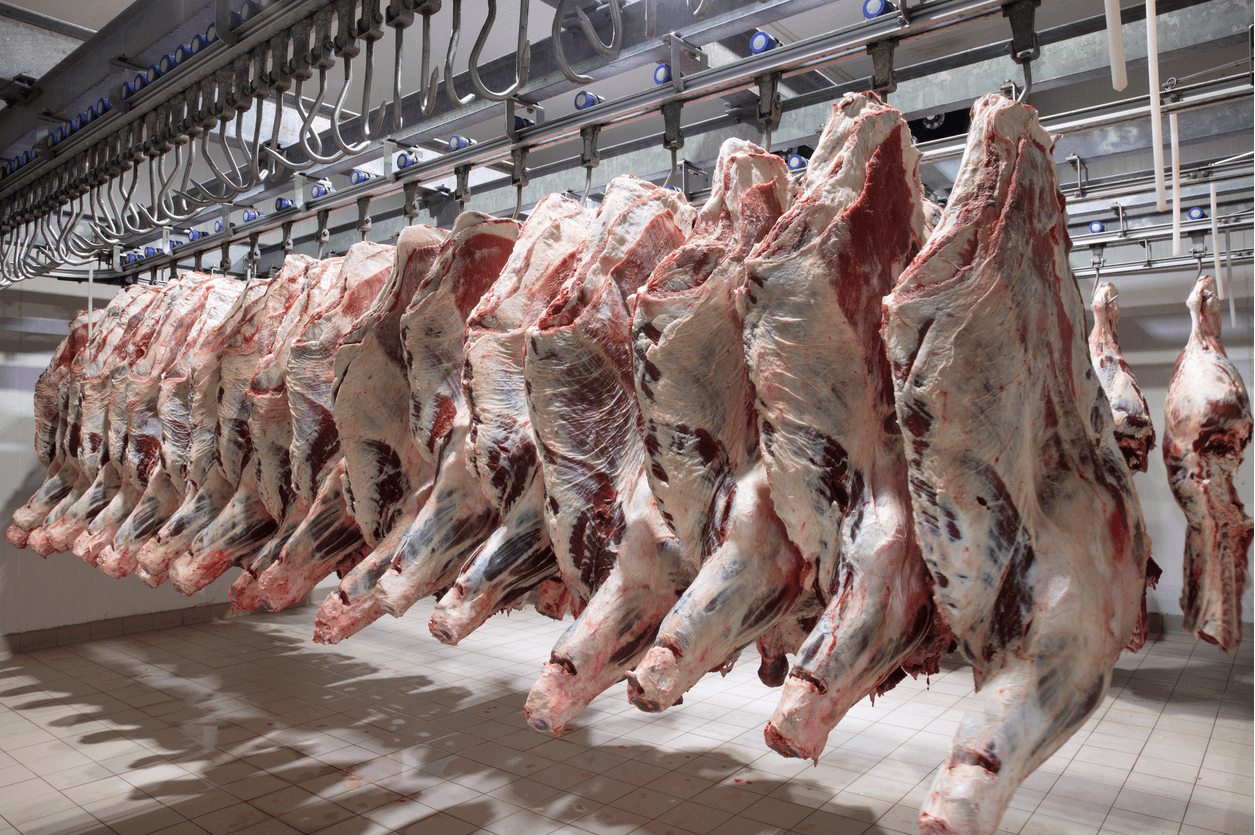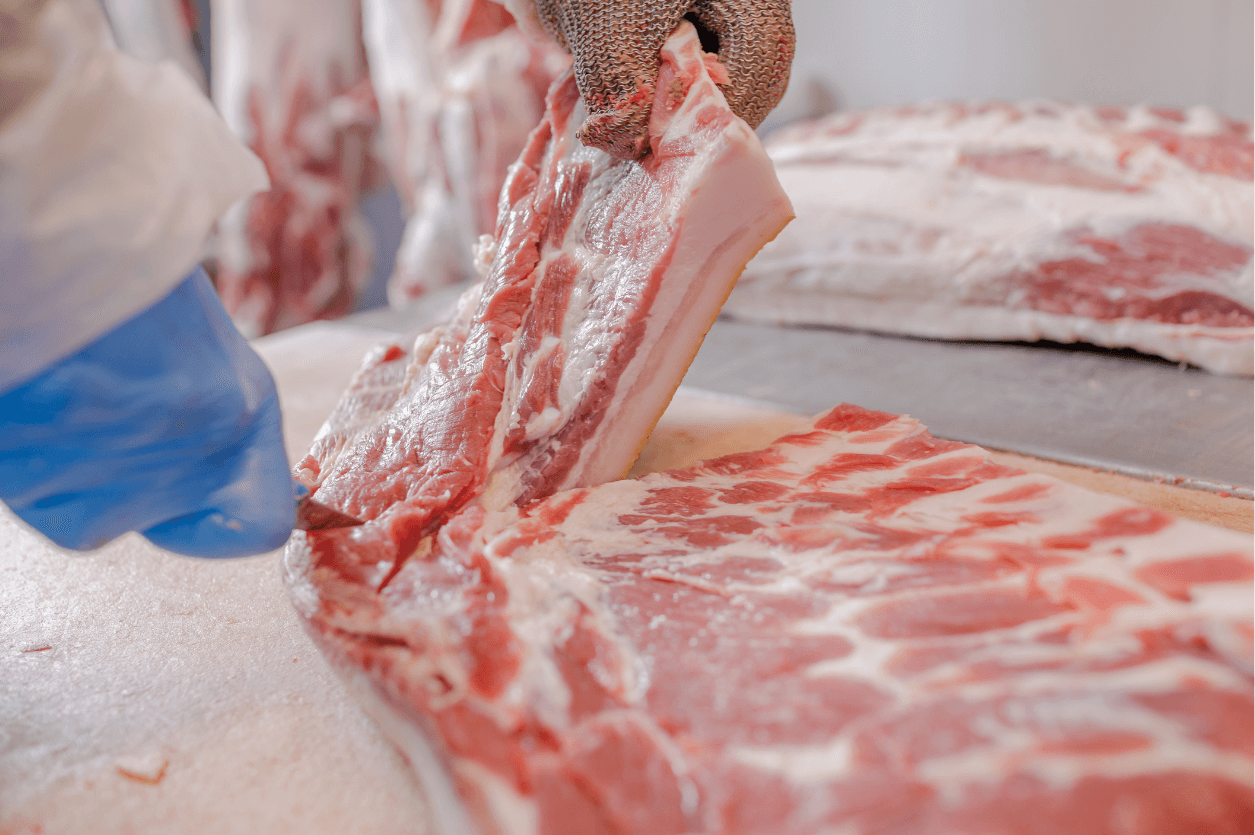Meat and Poultry Inspection Program (MPIP)
Who We Are and What We Do
Limited English Proficiency (LEP) individuals contact MDA at
573-751-8730 for alternative formats and languages.
Limited English
Proficiency Plan
Missouri Department of Agriculture’s Meat and Poultry Inspection Program does not discriminate on the basis of race, creed, ancestry, religion, age, handicap, sex, national origin citizenship, marital status, unfavorable discharge from military service, or disabled veteran or Vietnam veteran status in accordance with Federal, State and local law.
MPIP, in cooperation with the U.S. Department of Agriculture (USDA) Food Safety Inspection Service (FSIS), is administered by the Missouri Department of Agriculture, Division of Animal Health. MPIP is responsible for verifying the safety and wholesomeness of MPIP-inspected meat and poultry products sold to Missouri consumers. Meat and poultry products are an integral part of the food chain but can be associated with food borne diseases. Therefore, ensuring products produced in Missouri are safe is an important public health defense.



Inspection
MPIP provides inspection service to meat and poultry processing and distribution facilities to ensure Missouri consumers receive only safe, wholesome, unadulterated products. Inspectors check live animals and carcasses for signs of disease and enforce humane slaughter rules. Inspectors are available daily at official establishments that produce meat and poultry products for wholesale. They inspect labels bearing the Missouri State Inspection Legend to ensure ingredients are properly listed and nothing is false or misleading to consumers. Sanitation inspection is also part of an inspector’s daily role, as is monitoring construction, grounds, maintenance, cleaning and disinfecting food and non-food contact surfaces, and verifying appropriate record keeping.
Do I need inspection?
MPIP Inspection or USDA-FSIS inspection is required under the Federal Meat Inspection Act (FMIA) and Poultry Products Inspection Act (PPIA) when meat or poultry products are being wholesaled, or in some cases, sold to the end consumer. Please visit our “exemptions” page to see if you are eligible for a meat or poultry exemption via MPIP.
How do I apply for Inspection?
To obtain a Grant of Inspection with MPIP, in order to slaughter and/or process meat and/or poultry products and sell commercially within the state of Missouri, call MDA and ask to speak with either the MPIP Program Manager or Program Director. They will ask you to either send them a layout of your facility or schedule a site visit to ensure the building meets Title 9 CFR Part 416 requirements. They will also visit with you regarding Title 9 CFR Part 417 requirements, which all official establishments must follow to design and implement a food safety system. MPIP and USDA-FSIS require all official establishments that produce inspected meat and poultry products to design and implement HACCP (Hazard Analysis and Critical Control Point) systems.
Those who want to ship meat and meat products across state lines (interstate) should contact USDA-FSIS in Springdale, AR at (479) 751-8412.
What is considered "inspected"?
According to Title XVII AGRICULTURE AND ANIMALS, RSMo Section 265.300(7), “meat” is defined as, “any edible portion of livestock, poultry, or captive cervid carcass or part thereof.” Furthermore, RSMo Section 265.300(8), defines “meat product” as, “anything containing meat intended for or capable of use for human consumption, which is derived, in whole or in part, from livestock, poultry, or captive cervids.” Livestock may be defined as cattle, calves, sheep, swine, ratite birds including but not limited to ostrich and emu, llamas, alpacas, buffalo, bison, elk documented as obtained from a legal source and not from the wild, goats, or rabbits raised in confinement for human consumption. Poultry may be defined as, domesticated chickens, turkeys, ducks, geese, and squabs (young pigeons).
Consumers know their meat or poultry has been inspected because it bears a “mark of inspection” (AKA: legend, “bug,” etc.).


Why is my meat being held up at the processor?
Label approvals
Per Title XVII AGRICULTURE AND ANIMALS, RSMo Section 265.400, “The use of any label upon or accompanying any livestock, poultry, meat or meat products inspected under sections 265.300 to 265.470 shall be approved by the director before being used, and if the director finds that any label is false or misleading, he/she may prohibit the use of the label unless modified.”
Therefore, any label bearing the MPIP mark of inspection must have a label approval by the Missouri Director of Agriculture, or designee.
Producers interested in putting special claims on their products must first notify the official establishment they are currently working with and ask about applying these claims to their labels. The MPIP team is available to answer questions regarding claims on meat and poultry labels. Please contact the MPIP team at meatinspection@mda.mo.gov.
Establishments needing label approvals may submit completed forms to meatinspection@mda.mo.gov.
Exemption

To be considered “exempt” means to not be required to have a Grant of Inspection with either MPIP or USDA-FSIS based on operation type and where the product is being distributed (or isn’t). MPIP still conducts “inspections” of exempt facilities but enforces different requirements than those who have a Grant of Inspection. State and Federal Laws allow persons to slaughter and process their own livestock and poultry for their own, exclusive use without the benefit of inspection. This product may not, however, be sold commercially (i.e. wholesaled), donated, etc. This is referred to as the “Personal Use” exemption. Besides Personal Use, there are other exemptions you may be eligible for, if you qualify. Any persons operating under these exemptions, other than Personal Use, will need to apply with MPIP prior to operating, unless specifically mentioned.
Do I qualify for an Exemption?
Can "Not For Sale" labeled meat be donated?
Custom exempt processed products may not be sold or donated. The person who owns the animal prior to slaughter must be the same person, or live in the same household, that will use the meat products.
If you purchase an animal that will be processed at a custom exempt facility, the producer must provide an opportunity for you to view the animal you are purchasing, prior to slaughter, if you desire to do so. Ensure you practice biosecurity when visiting another farm.
MPIP recommends visiting the custom exempt facility prior to taking your animals to be slaughtered and processed. Having a producer/customer/butcher relationship is the intention of this rule and a good working relationship between these entities is important.
Can I sell my live animals to customers who want to process them as "custom exempt"?
Yes, many Missouri producers sell livestock ready to slaughter to individuals who may only need a portion of a beef carcass for themselves and their families. The animal (or portion of an animal) must be purchased prior to taking the animal to slaughter and the person dropping off the animal(s) must have the name and address of every owner/consumer associated with the carcass. The custom exempt operator will be required to keep this documentation throughout the process and equal amounts must be distributed evenly between each owner/consumer, if an animal has more than one.
Selling Meat and Poultry in Missouri
Our compliance team monitors meat and poultry products in-commerce to ensure distributors and retailers are keeping appropriate records and following proper food safety precautions. Compliance Investigators register farm-to-fork producers interested in selling meat or poultry and respond to consumer complaints. If you are interested in selling inspected meat or poultry in the state of Missouri, contact the Compliance Investigator in your area to ask for a farm-to-fork registration.
I’m from out of state, but I want to sell meat in Missouri, do I need to be registered?
I want to sell my meat off the farm, at farmers markets, and possibly to retail stores. What steps do I need to take?
I’m opening up a brick-and-mortar retail store and selling meat. Do I need a license with MPIP?
Find a Processor Near Me
follow the link above to an offsite map showcasing Missouri processing facilities
File a Complaint
MPIP enforces State and Federal laws, which protect Missouri consumers and small business owners. MPIP’s mission is to ensure the safety and wholesomeness of meat and poultry products produced and distributed by entities under MPIP’s authority. MPIP and USDA-FSIS program mission is not to ensure the quality of meat and poultry products. Many consumers contact MPIP regarding issues that occur during slaughter at a custom exempt facility. Unfortunately, most of these complaints are beyond MPIP’s authority and result in disputes remaining between the customer and the processor. We do, however, need to know if there is an issue or a concern we can resolve.
If you would like to file a complaint about meat or poultry products in Missouri, call the MPIP office at (573) 522-1242
Understanding How Much Meat You Will Receive
Consumers who buy a live animal from a local cattle producer for custom processing are often surprised by the amount of beef they receive, the amount of freezer space needed, and that they did not get back the entire live weight of the animal in retail cuts. Therefore, it is important to understand how to estimate how much meat you will receive when purchasing an animal to harvest.
Dressing Percentage is an important term to remember, as it represents the portion of the live animal weight that transfers to the hot carcass weight.
Dressing percentage is calculated as: (hot carcass weight ÷ the live weight) x 100.
The hot carcass weight is the weight of the unchilled carcass in pounds after the head, hide and internal organs have been removed. For most fed cattle, the hot carcass weight will be approximately 60 to 64 percent of live animal harvest weight. For example, a 1,400 pound animal with a hot carcass weight of 880 pounds has a dressing percentage of approximately 63%, which is calculated as follows:
(880 hot carcass weight ÷ 1400-pound live weight) x 100 = 63%.
It is not uncommon for the buyer of a live animal to question, “The dressing percentage of my 1400-pound steer was 63% but I only got 550 pounds of meat. Where is the rest of my meat?” The calculation of dressing percentage is based on hot carcass weight. The hot carcass weight includes bones, excess fat and moisture loss that will not be packed and wrapped for home consumption. The hot carcass weight is not the actual amount of meat that the consumer will put in the freezer.
Many factors can affect the dressing percentage. Anything that adds weight to the live animal but does not appear on the carcass will lower the dressing percentage. Factors that might add to the live animal weight but not be included in the hot carcass weight include:
- Hide
- Horns
- Pregnancy
- Mud and/or manure on the hide
- Gut fill
All beef animals are not created equal. Therefore, the dressing percentage is not consistent from one animal to another. Some of the primary factors that influence the dressing percentage include breed of the animal (dairy vs. beef), live weight, and how it was finished (grain fed or grass fed).
Questions about a Federal establishment or product from a Federal establishment?
If the product in question bears a USDA mark of inspection, or if you had an animal processed at a USDA-FSIS facility, please contact the USDA Meat and Poultry Hotline at 1-888-674-6854.
